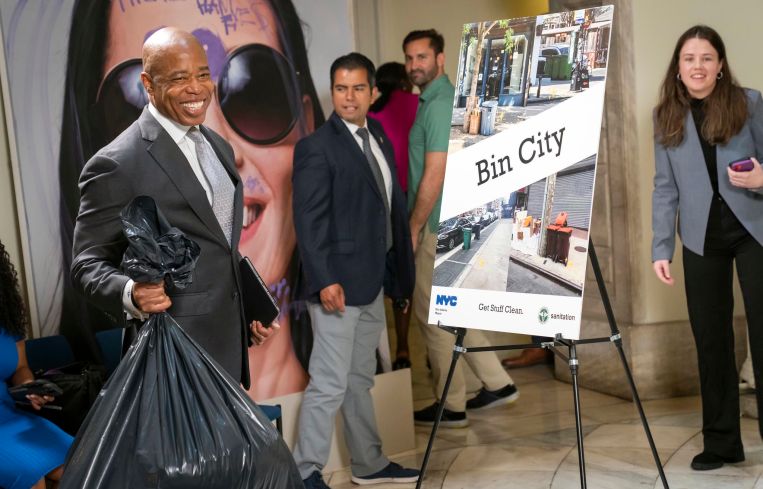Rat-Weary NYC Orders Trash Bags Inside Containers. Restaurants Ask ‘But How?’
By Aaron Short June 29, 2023 12:54 pm
reprints
New rules that would eliminate the city’s festering mounds of trash bags piling up outside food establishments are set to take effect soon, but restaurateurs say they can’t store their waste on their properties.
In an effort to cull New York’s abundant rat population, Mayor Eric Adams and Department of Sanitation Commissioner Jessica Tisch announced that the city would require all food-related businesses and chain stores to dispose of their trash and compostable waste in secure containers instead of dumping plastic bags on the sidewalk.
“The goal was to remove trash off our streets, number one. To deal with the unsightliness of it, and how it impacts on the feeling of being a clean city,” Adams said Wednesday at a City Hall press conference. “But as I say over and over again, I hate rats, and rats love garbage bags. We cannot coexist.”
Restaurants want the unsightly trash heaps removed from their premises, too. But hospitality advocates worry the new rules will shift the burden to businesses that may not have the room to store the new containers inside their properties.
“The Department of Sanitation’s mandate is impractical and creates big problems for small restaurants that will have to store big dirty garbage cans in their food preparation and customer seating areas or leave thousands of trash containers permanently strewn on sidewalks across the city,” Andrew Rigie, executive director of the trade group the New York City Hospitality Alliance, said in a statement.
The rule, which is set to take effect July 30, would affect about 40,000 restaurants, grocery stores, catering companies and bodegas, or nearly one out of five of the city’s businesses. In addition, the city announced Wednesday that it’s moving to apply its containerization policies to chain businesses with five or more locations within the five boroughs.
Once both rules go into effect, Sanitation officials estimate nearly 4 million pounds of waste generated each day would be boxed up, no longer providing sustenance to New York’s estimated 2 million hungry rats.
“New York is the home of the best restaurants in the world. I know it, you know it — and the rats know it, too,” Tisch said. “When you leave food behind, they’re ready for a gourmet meal, with the black bags outside food-related businesses basically serving as a to-go box for the rats. That ends now.”
Adams has moved to curb the city’s growing rat population since taking office, and in April appointed Kathleen Corradi as the city’s first ever rat czar.
Aside from asking businesses to store their trash inside containers, the Sanitation Department is considering adding on-street containers for residents to use, which the agency estimated would occupy about 150,000 parking spaces, but not in the densest parts of the city.
Details about where exactly the trash containers for commercial businesses will be located are still being worked out. The rules include flexibility for businesses that can store their bins inside or outside their property within three feet of their property line.
Rigie believes both locations have their downsides. Placing garbage containers inside near food preparation stations could repel customers or attract vermin that results in health code violations. Putting them outside could block windows or limit their ability to install a new sidewalk cafe, which the mayor and New York City Council leaders reached a long-anticipated agreement to allow last month.
“Neighboring businesses and residential buildings will undoubtedly complain when food businesses permanently store a bunch of large rigid and smelly garbage containers right next to their entrances, as will community boards and local groups that may not want thousands of garbage cans permanently stationed in front of buildings, especially when there are multiple containers that get knocked over, strewn about at night,” Rigie testified at a Department of Sanitation rulemaking hearing last week.
Some transportation advocates propose designating curb space often used for street parking for the new trash containers. Rigie has suggested using curbside space as well.
“If these containers are on the sidewalk (instead of the curb lane) this is completely absurd,” Sara Lind, co-executive director of Open Plans, a nonprofit promoting livable streets, tweeted. “Our sidewalks are too narrow already. Public feedback overwhelmingly made this point.”


